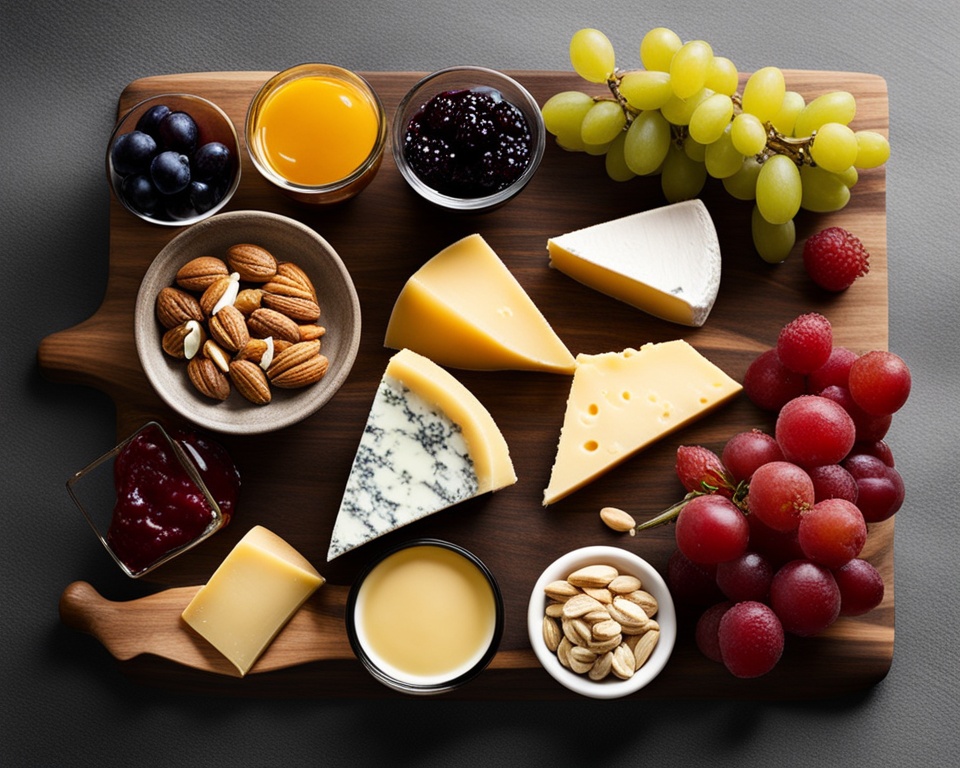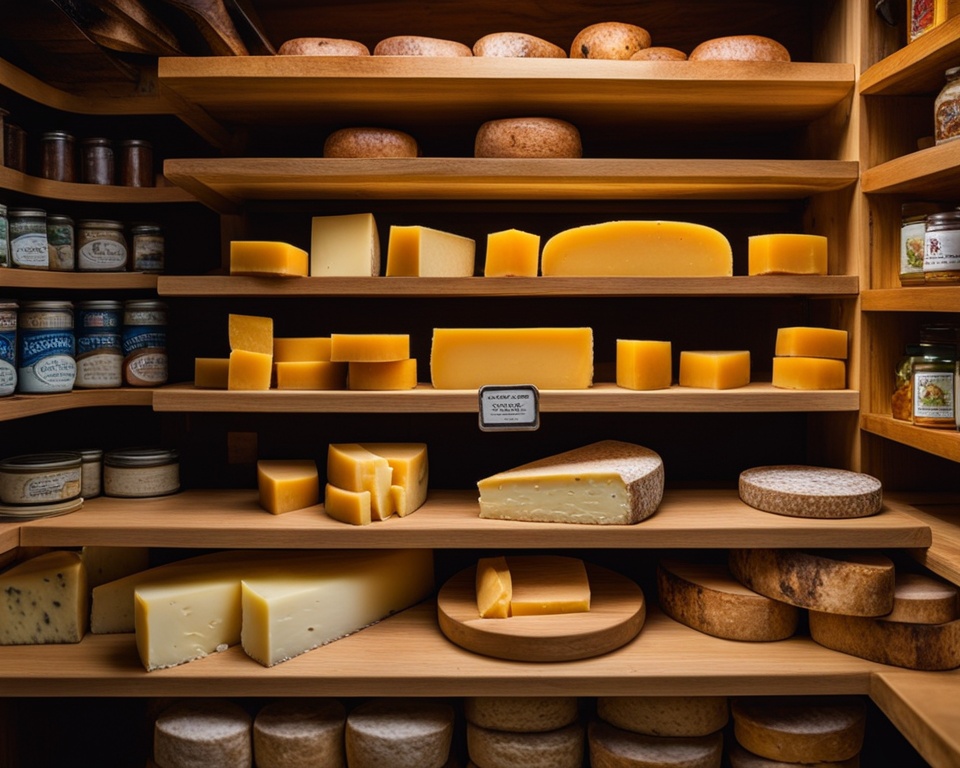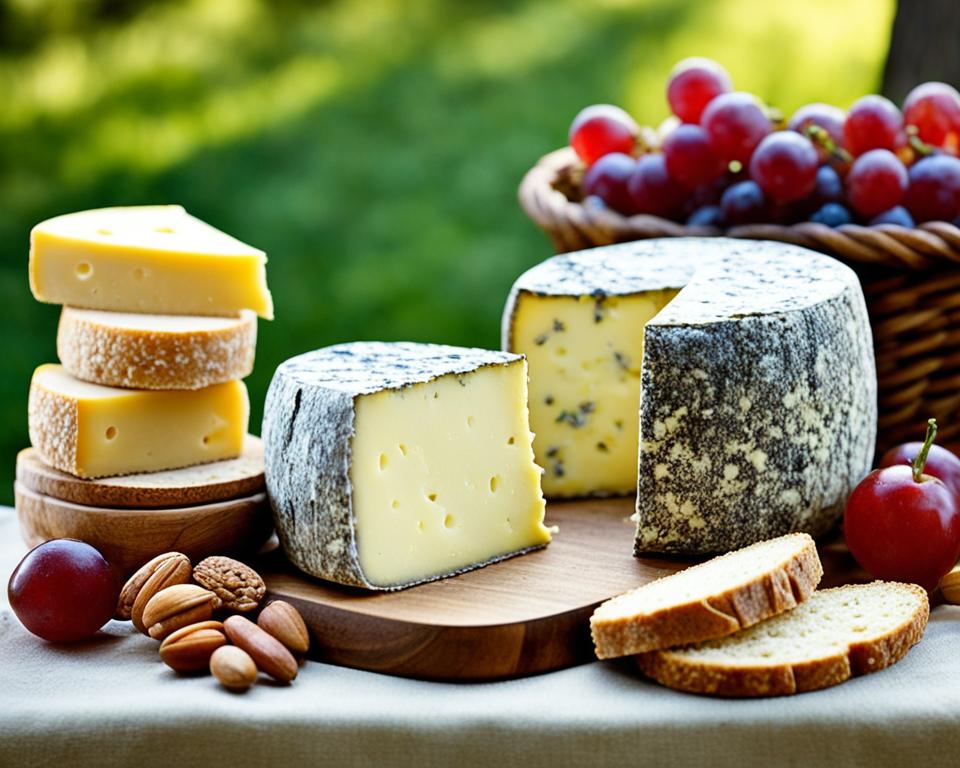Semi cheese is a special type of cheese that brings together great flavors and textures. This guide will explore where semi cheese comes from, how it’s made, and the many types available. It aims to give readers a better understanding of this beloved food.
Read interesting things at : legend-of-raphael
Key Takeaways
- Semi cheese is a versatile dairy product with a wide range of flavors and textures.
- The cheesemaking process for semi cheese involves specific ingredients, equipment, and aging techniques.
- Artisanal semi cheese producers are at the forefront of innovation, offering unique and flavorful varieties.
- Semi cheese can be enjoyed in a variety of culinary applications, from pairing with wine to cooking and baking.
- Consuming semi cheese provides several health benefits, making it a nutritious addition to one’s diet.
What is Semi Cheese?
Semi cheese, also known as semi-hard cheese, sits between hard and soft cheeses. It’s a versatile dairy product with a rich history and many varieties. This section explores the definition and origins of semi cheese, along with its different types.
Definition and Origins
Semi cheese has a firm, yet creamy texture. It’s between the crumbly hard cheeses and the soft, spreadable ones. These cheeses are aged longer than soft ones but not as long as hard ones. This aging gives them a deeper, more complex taste.
The history of semi cheese comes from European cheesemaking traditions. Countries like the Netherlands, Switzerland, and the United Kingdom are famous for their semi cheese. Each region has its own unique semi cheese, with special flavors and ways of making them.
Types of Semi Cheese
There are many types of semi cheese, each with its own flavor, texture, and way of making it. Some popular ones include:
- Gouda: A semi-hard Dutch cheese with a smooth, creamy, and slightly nutty taste.
- Gruyère: A Swiss semi-hard cheese with a firm, dense texture and a complex, slightly sweet flavor.
- Cheddar: A beloved semi-hard cheese from the United Kingdom, ranging from mild to sharp in taste and known for its crumbly texture.
- Emmental: A Swiss semi-hard cheese with large, distinctive holes and a nutty, slightly sweet flavor.
- Provolone: An Italian semi-hard cheese with a smooth, slightly elastic texture and a mild, slightly sweet or smoky flavor.
These are just a few examples of the many semi cheese varieties out there. Each has its own unique traits and uses in cooking.
The Cheesemaking Process
Making semi cheese is a detailed process. It needs the right mix of ingredients, tools, and techniques. Every step, from picking the best milk to aging the cheese, is key to its taste and texture.
Ingredients and Equipment
To start making cheese, you need top-quality milk, rennet, and starter cultures. You also need special gear like cheese vats, molds, and aging chambers. These tools help make the cheese consistent and high-quality.
Step-by-Step Guide
- Milk Preparation: First, pick and pasteurize the milk for safety and consistency.
- Coagulation: Add rennet to the milk, which makes it curdle and form a solid curd.
- Cutting and Cooking: Cut the curd into small bits and cook it to release whey and make it firm.
- Draining and Salting: Drain the curd and add salt to improve flavor and help the rind form.
- Molding and Pressing: Put the curd in molds and press it to shape the cheese.
- Aging and Ripening: Move the cheese to a controlled aging area to develop its unique taste and texture.
Every step in this detailed process is important for the final taste, texture, and look of the semi cheese. It turns into a true work of art in the kitchen.
Aging and Ripening
The aging and ripening of semi cheese is key to bringing out its best flavors. This process combines time, temperature, and microbes. It turns a fresh, mild cheese into a complex, tasty treat.
The aging starts with the cheese in special places like caves or rooms with set temperatures. Here, the cheese changes in ways that affect its flavors and textures.
Important to aging is the growth of special bacteria. These tiny helpers break down the cheese’s lactose. This makes the semi cheese taste unique. Aging times can be short, like a few weeks, or long, up to several years, depending on what’s wanted.
| Aging Duration | Flavor Profile | Texture |
|---|---|---|
| 4-8 weeks | Mild, buttery | Soft, pliable |
| 3-6 months | Nutty, complex | Firm, slightly crumbly |
| 1-2 years | Robust, earthy | Hard, crystalline |
As cheese ages, it gets firmer and more developed. Proteins break down, and moisture is released. This creates a variety of textures, from soft to hard and crystalline.
“Aging is the process that transforms a simple cheese into a work of art, revealing hidden depths and unexpected delights with each passing day.”
Knowing how aging and ripening work helps cheesemakers make semi cheese with amazing flavors and textures.
Flavors and Textures
The world of semi cheese is full of flavors and textures. It offers a wide range of tastes for cheese lovers. From tangy and crumbly to smooth and creamy, there’s something for everyone.
Flavor Profiles
Semi cheese comes in many flavors, each with its own special taste. Cheese flavors can be mild or bold, with hints of buttery, nutty, or sharp. The type of milk, aging process, and how it’s made affect the flavor.
- Mild and creamy semi cheeses have subtle flavors that are gentle on the taste buds.
- Semi cheese with a strong character can have earthy, tangy, or even a bit of a pungent taste, making it exciting.
- Some types have a mix of sweet and salty flavors, creating a perfect taste balance.
Textural Characteristics
The cheese textures of semi cheese vary a lot, from soft and creamy to firm and crumbly. This makes it great for many dishes, from dips to toppings.
- Soft and creamy semi cheeses melt easily, adding a rich feel to dishes.
- Firmer semi cheese types are great for slicing or grating, with a nice chew.
- Some semi cheeses are both creamy and crumbly, offering a unique texture.
Whether you like smooth or complex tastes, the cheese flavors and cheese textures of semi cheese are worth trying. They offer a wide range of sensations to enjoy.
Semi Cheese Varieties
Semi cheese is a key part of gourmet cheese, known for its unique flavors and versatility. It includes a variety of cheeses, each with its own taste and uses. From creamy Brie to tangy Gouda, these cheeses show the skill of cheesemakers.
Gouda, a Dutch classic, is a favorite semi cheese. It has a smooth texture and tastes slightly sweet and nutty. It’s great for grilled cheese, cheese boards, and even desserts.
Brie, from France, is another semi cheese loved by many. It has a soft, creamy inside and a tasty rind. Brie goes well with fresh fruits, bread, and white wine, making it perfect for parties.
Fontina, from Italy, is a semi cheese with a mild, nutty flavor. It’s great for melting, like in fondue, or adding to salads and pasta.
Gruyère, a Swiss cheese, is known for its strong taste. It has flavors of caramel, mushroom, and a bit of sharpness. This cheese is a treat for those who like bold flavors.
The semi cheese world offers a wide range of tastes, from creamy Brie to nutty Gruyère. Trying these cheeses can deepen your love for cheesemaking and open up new kitchen possibilities.
Pairing and Serving Suggestions
Exploring semi cheese pairings is a fun journey for food lovers. These versatile cheeses have many flavors that match well with wine and food. Whether you’re hosting a party or just want to improve your meals, learning to pair semi cheese can make your food better.
Wine Pairings
Pairing semi cheese with wine opens up many options. The creamy taste of semi cheese goes well with the right wine. For example, Gouda cheese is great with a fruity red wine like Pinot Noir or Malbec.
On the other hand, Cheddar cheese is balanced by a crisp white wine, such as Sauvignon Blanc or Pinot Grigio.
Food Pairings
Choosing the right foods to serve with semi cheese can make your meal amazing. A classic choice is to pair aged Cheddar with crackers, grapes, and fig jam. The cheese’s sharp taste is enhanced by the sweetness of the fruit and the crunch of the crackers.
Another great option is to serve Brie cheese with a baguette, honey, and toasted walnuts. This lets the cheese’s creamy texture mix with different flavors and textures.

When pairing semi cheese, the key is to balance its flavors and textures with the right foods. Try different combinations to find what you like best. This will help you impress your guests with your semi cheese pairing skills.
Health Benefits of Semi Cheese
Semi cheese is more than just a tasty treat; it’s also good for your health. It’s packed with nutrients that can make your diet better. This cheese is a great choice for anyone looking to eat well.
Semi cheese is full of calcium, which is key for strong bones and teeth. Eating it regularly can help you get enough calcium. This is good for your bone health.
It’s also a good source of protein. Protein helps your muscles grow, repair, and stay strong. Adding semi cheese to your meals means you’re getting plenty of protein.
Plus, semi cheese has healthy fats like omega-3s. These fats are good for your heart and can lower the risk of some diseases. Eating semi cheese can keep your heart healthy.
| Nutrient | Amount per 100g of Semi Cheese |
|---|---|
| Calcium | 720mg |
| Protein | 25g |
| Omega-3 Fatty Acids | 0.2g |
It’s great to eat semi cheese, but remember to do it in moderation. If you have lactose intolerance or special dietary needs, talk to a doctor before adding it to your diet.
In summary, semi cheese is good for your bones and heart. Knowing what’s in it helps you make smart food choices. It’s a great way to live a healthy life.
Storing Semi Cheese
Storing semi cheese right is key to keeping its quality high and making it last longer. Whether you love cheese or just enjoy it now and then, knowing how to store it can really help. It makes a big difference in how you experience its unique tastes and textures.
Temperature and Humidity
The best place for semi cheese is in a spot that’s between 40-50°F (4-10°C). It should also be 85-90% humid. This keeps the aging process slow and stops the cheese from drying out or getting mold.
Wrapping and Packaging
For cheese preservation, wrap semi cheese in something breathable like parchment paper or cheese paper. Don’t use plastic wrap because it can keep moisture in and cause mold. You can also store it in a cheesebox or a container lined with cheese paper to keep the right humidity.
Slice and Reseal
When you’re serving semi cheese, cut only what you’ll use and seal it back up. This keeps air out, which can dry out the cheese or make it taste bad. Use a cheese slicer or a sharp knife for thin, even slices to keep the cheese looking and tasting great.
| Storage Tip | Recommended Practices |
|---|---|
| Temperature | 40-50°F (4-10°C) |
| Humidity | 85-90% relative humidity |
| Wrapping | Breathable materials (parchment paper, cheese paper) |
| Slicing | Slice only what you need and reseal the remainder |
By following these easy tips, you can keep your semi cheese tasting great, feeling right, and staying fresh. This lets you enjoy all the special qualities of this loved dairy product.

Artisanal Semi Cheese
In the world of semi cheese, artisanal cheesemakers are the stars. They make artisanal semi cheese that delights cheese lovers. Their focus on quality and deep knowledge of making cheese make their products stand out.
Artisanal Cheesemakers
Artisanal cheesemakers are the heart of the cheese world. They mix old techniques with new ideas. They pick the best ingredients, often from local farms, to make semi cheese that shows off the area’s taste.
They watch over the aging and ripening, bringing out the unique tastes and textures. This makes their artisanal cheese truly special.
Artisanal Cheese Shops
Artisanal cheese shops are key to enjoying these cheeses. They’re often family-run and full of gourmet cheese lovers. These shops offer a wide range of semi cheese from around the globe.
The staff at these artisanal cheese shops love to share their knowledge. They help customers discover the different tastes and qualities of each artisanal cheese.
Artisanal cheesemakers and cheese shops work together to celebrate semi cheese making. They help cheese lovers try all the flavors and textures of artisanal semi cheese. This makes eating cheese a more exciting experience.
Semi Cheese in Cooking
Semi cheese is a versatile dairy product that can elevate many dishes. It adds creaminess and flavor to both savory and sweet dishes. Whether you’re a pro or new to cooking, semi cheese can make your meals richer and more sophisticated.
Recipes and Cooking Tips
Exploring different recipes is a great way to use semi cheese. Try it in classic grilled cheese or creamy mac and cheese. For a twist, add it to quiches, omelets, or savory tarts for a fancy breakfast or brunch.
If you like sweets, semi cheese can surprise you. Mix it into cheesecake batter for a creamy treat. Or, use it as a topping for fruit pies or tarts. It can even be the base for a rich ice cream or gelato, offering a smooth and indulgent taste.
When cooking with semi cheese, think about how it melts and tastes. Soft types melt well, perfect for sauces, dips, and pizza toppings. Harder cheeses can be grated or crumbled, adding texture to salads, pasta, and more.
| Dish | Semi Cheese Recommendation |
|---|---|
| Grilled Cheese Sandwich | Cheddar, Gouda, or Provolone |
| Mac and Cheese | Cheddar, Gruyère, or Parmesan |
| Quiche | Brie, Feta, or Goat Cheese |
| Cheesecake | Cream Cheese, Mascarpone, or Ricotta |
Experimenting with semi cheese is key to success in the kitchen. Try new flavors and techniques to let your creativity flow. With practice, you’ll become a pro at using semi cheese in your cooking.
The Future of Semi Cheese
The cheese industry is always changing, and semi cheese is set to grow. More people want artisanal and specialty dairy products, leading to new semi cheese flavors. Cheesemakers are trying new techniques and using different types of milk. This means more semi cheese options for those who love food.
There’s a big push for sustainable cheese making too. Artisanal cheesemakers are using local, high-quality milk and green production methods. This appeals to those who care about health and the planet.
The cheese market is expected to grow, and semi cheese is leading the way. As people keep trying new semi cheese flavors, there will be even more choices. Cheesemakers and stores will offer a wider range of semi cheese to meet what consumers want.
